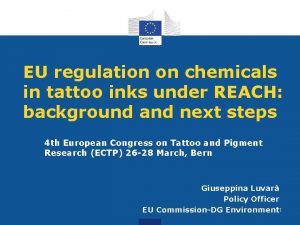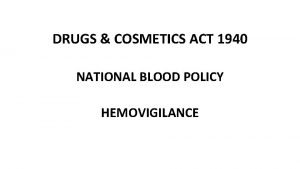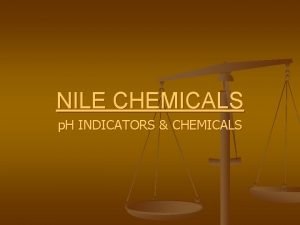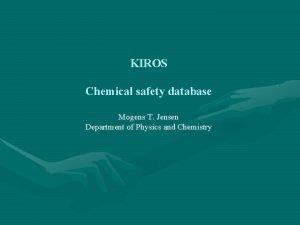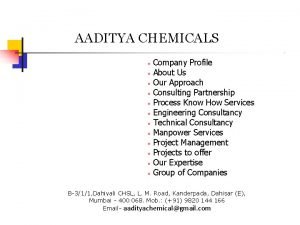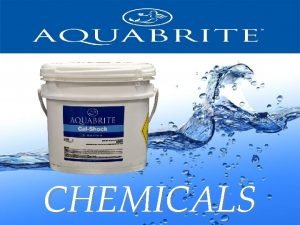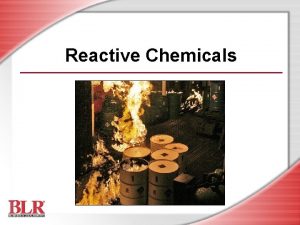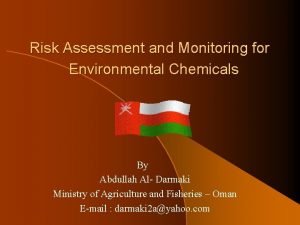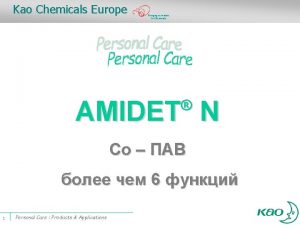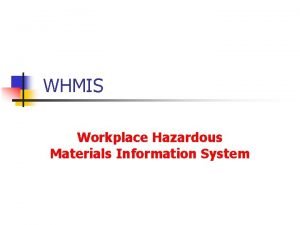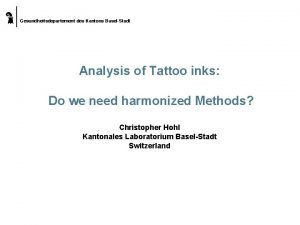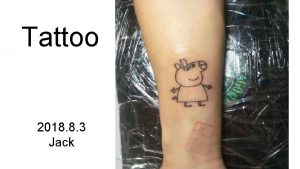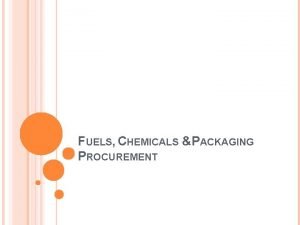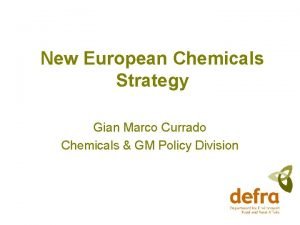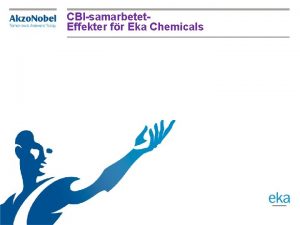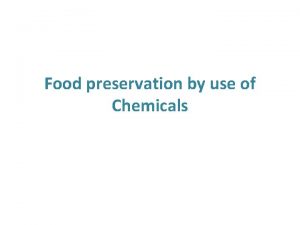EU regulation on chemicals in tattoo inks under

























- Slides: 25

EU regulation on chemicals in tattoo inks under REACH: background and next steps 4 th European Congress on Tattoo and Pigment Research (ECTP) 26 -28 March, Bern Giuseppina Luvarà Policy Officer EU Commission-DG Environment 1

Tattoo inks: current situation • Tattoo inks injected to create a tattoo or permanent make-up (PMU) – in the dermis or other parts of the body. • 12% of European citizens have tattoos • prevalence in some age groups more than double • 3 -20% of the general population – PMU (or cosmetic tattoo) 2

Tattoo inks and studies • • 3 Tattoo inks comprised of colorants and auxiliary ingredients: • Colorants not developed for the purpose of injecting in the skin Studies have reported: • Large number of mild cutaneous complaints related to tattoos • Small number of persistent cutaneous complications requiring medical treatment (including removal) • Small number of systemic reactions

Tattoo inks – legal gap? • • 4 7 EU and 2 EEA Member States have national legislation based on Council of Europe resolution (Res. AP(2003)2 or Res. AP(2008)1) Not covered by Cosmetics Regulation Not covered by Pharmaceuticals Regulation Tattoo inks are generally covered by the General Product Safety Directive in the EU • Number of RAPEX notifications increasing • Some tattoo inks contain substances that are banned in hair dye

Tattoo ink’s passage in the body (1) • Not all pigment remains in the dermis indefinitely: • The pigment, initially rapidly, decreases over time; only 1 -13% remaining in the skin after several years (Lehner, et al. , 2011) • The reduction of the pigment in the dermis is due to three main mechanisms: • bleeding during or directly after tattooing; • transport away from the skin via the lymphatic or blood vessel systems; • decomposition due to repeated exposure to solar radiation or other processes that reduces the size of the particles 5

Tattoo ink’s passage in the body (2) • Transportation of tattoo pigment particles to regional lymph nodes is well documented in animal and human studies • The translocation of tattoo pigment particles to the liver is shown in animal studies • The migration of nanoparticles in other organs is documented in studies • Soluble ingredients are likely to be metabolised and excreted from the body within weeks 6

EU Commission action and REACH (Chemicals Regulation) procedure (1) • Tattoo ink: problem identified, risk not adequately controlled • EU Commission asks European Chemicals Agency (ECHA) to prepare a restriction dossier • ECHA has 12 months to finalise the dossier (risk assessment, analysis of alternatives , socio economic impact) • Once finalised the dossier is assessed by two ECHA Committees , risk assessment (RAC) and socio economic analysis (SEAC) 7

REACH procedure (2) • RAC has 9 months to finalise its opinion • SEAC has 12 months to finalise its opinion • During this period there are two consultations , one of 6 months and another one of 2 months where everybody can submit comments which are assessed by the two ECHA Committees. 8

EU COMMISSION request to ECHA Scope • Council of Europe resolutions • CMR and skin sensitising substances • Substances restricted under the Cosmetic Products Regulation (CPR) • In addition, ECHA assessed substances with effects on the dermis and eye tissues • Norway, Italy, Denmark and Germany worked with ECHA to prepare the restriction dossier and proposal. 9

Approach to demonstrating risk Substance group Approach Harmonised classification (HC) as eye irr/dam, skin irr/corr, skin sens, carc and mut, incl. PAH & lead compounds Qualitative assessment anchored on the conclusions of risk to human health Cosmetics Products Regulation (CPR) substances – Annex II & IV Qualitative assessment anchored on conclusions of risk to human health in CPR (Semi-)quantitative assessment with derivation of DN(M)ELs and demonstrating risk on the basis of reasonable exposure estimates Primary aromatic amines & azo colourants Reprotoxic HC Selected impurities Methanol Remaining impurities in Table 3 and remaining azo colourants in Table 2 of Co. E 10 On the basis of existing legislation

Approach to deriving concentration limits • Qualitative approach to demonstrating risk: • Practical approach • Existing legislation (e. g. , CPR, CLP Regulation) • (Semi-)quantitative approach to demonstrating risk: • DN(M)ELs were compared to exposure assessment in the exposure scenario • Content of the hazardous substance corresponding to a Risk Characterisation Ratio (RCR) < 1 or an excess lifetime cancer risk < 10 -6 was calculated 11

Concentration limits Substance(s) Risk-based CL Practical CL Comments Carc/Muta Should not contain 0. 00005 as for PAHs Skin sensitisers Should not contain 0. 001 95 th perc. level protection for strong SSs Reprotox Should not contain 0. 001 DBP, overall assessment of reprotoxic substances Irritants/Corrosives Should not contain 0. 01 GCL for Cat 2/100 Azo colourants of concern Should not contain 0. 1 practical limit to discourage use PAAs of concern Should not contain 0. 00006 0. 0005 DMEL for carc. ; higher limit due to technical achievability CPR Annex II, IV col. g Should not contain 0. 00005 as for PAHs Annex IV limits 0. 00005 Should not contain 0. 00005 PAHs 0. 0000005 Ba. P as per REACH Annex XVII #50 and Co. E Res. AP(2008)1 10. 9 11 OEL & realistic worst case exposure scenario CPR Annex IV col. h-i Hazardous PAHs Methanol

Impurities Substance(s) Risk-based CL Practical CL Comments Should not contain 0. 00005 as for Carc Barium - soluble Impurities 0. 056 0. 05 corrected for oral abs. , rounded Copper 0. 025 corrected for oral absorption Lead 0. 00007 quantitative derivation of CL Zinc 0. 23 0. 2 based on DNEL for humans; rounded Should not contain 0. 0005 technically achievable limit Arsenic Nickel 13

Other impurities • • 14 Cobalt Cadmium Chromium(VI) Mercury Selenium Antimony Tin

Impurities in Res. AP(2008)1 Table 3 All the limits were discussed by ECHA Risk assessment Committee Co. E Res. AP CL Risk-based CL Practical CL Comments Cadmium 0. 00002 Should not contain 0. 00005 as for carc/muta Chromium (VI) 0. 00002 Should not contain 0. 00005 as for carc/muta Cobalt 0. 00002 Should not contain 0. 00005 as for carc/muta Mercury 0. 00002 Should not contain 0. 00005 as for Annex II CPR Antimony 0. 0002 Should not contain 0. 00005 as for Annex II CPR Selenium 0. 0002 as in Co. E Res. AP 0. 00005 as for carc/muta Substance(s) Organic tin (0. 005 for tin) Should not contain


Colorants • • 17 19 colorants banned for use in hair colours are proposed to be banned by RAC and SEAC in tattoos inks. Possibility for a transitional period for 2 colorants Pigment Blue (PB 15: 3) and Pigments Green 7 (PG 7)

• Additional conditions • Transitional period of one year • Will allow sufficient time for actors in the supply chain to meet the proposed requirements as well as it will accelerate a full implementation of this restriction • Assuming that production of non-compliant inks will stop immediately after adoption of this restriction, 12 months is sufficient for the industry to comply

Additional conditions • Colourants in Annex IV of CPR with conditions on their use • Onus on tattoo artists/practitioners to ensure that compliant inks are used for tattooing procedures • Onus on who places tattoos inks on the market to provide specific labelling on the ink products produced and imported in EU • Restriction proposal provides clear definitions of tattoo and PMU procedures, which are a prerequisite for enforcement

Other measures • Hygienic requirements, registration, certification, training not in the scope, but under national jurisdiction • Obligatory informed consent not in the scope, but could be introduced under national jurisdiction • Under national legislations based on Co. E Res. APs systems are in place to monitor compliance and to share information on enforcement actions on dangerous products (RAPEX)

• Comments received from the public consultation MSCA, NGOs • the issue of cumulative effects of hazardous substances in tattoo inks • endocrine disruptor properties relevant for the restriction • issues related to analytical methods • review clause and “positive list” recommended (also by Ind and individuals) • data on analysed tattoo inks provided… Industry • longer transition period required (up to 5 years) with justification • CLs for Cr(VI) and Pb in carbon black too low no enough data for evaluation • restriction which does not regulate risks not related to chemicals will not be efficient enough support for a stand-alone regulation • concern that EU manufacturers will not be able to comply with the restriction - non-compliant products will be illegally present on the market… Academic institution, individuals • • • support for a stand-alone regulation concern about health risks of derogated pigments importance of training and licensing…

Uncertainties Exposure, hazard and risk assessment for intradermal exposure inadequately explored Unknown decomposition products of tattoo colourants in the skin metabolism, sun exposure, tattoo removal (e. g. laser) Pigments as nanoparticles Intradermal route considered whenever possible (i. e. for skin irritants) Correction factor for oral absorption applied where relevant (Cu, Ba) Exposure scenario: realistic worst case (amount of tattoo ink injected) or worst case (complete bioavailability of injected tattoo inks for fullcoloured full-body tattoo) risk overestimation Available data insufficient to assess Restriction’s reviews important! Unknown alternatives, health risk inadequately explored Uncertainties in epidemiological data EU-harmonised diagnostic codes for tattoo-related adverse effects Non-existent or not standardised analytical methods Practical CLs expected to promote development EU project on analytical methods

• ECHA Committees are of the opinion that these uncertainties do not present obstacles for implementation of the proposed restriction • On the contrary, this restriction could be an important initiative for the scientific community to fill above stated knowledge gaps Ø Although popularity of tattooing began to increase more than a decade ago, there is a significant lack of data on toxicokinetics, hazards and risks of intradermally injected chemicals!

Timeline of the full procedure • RAC opinion adopted 20 November 2018 • SEAC opinion adopted on 14 March 2019 • Trasmission of the two opinions to the EU Commission by mid of April • EU Commission has 3 months to preparare the Regulation to amend Annex XVII to REACH • The Regulation will be voted by Member States with the scrutiny of the EU Parliament and the Council (3 months) • After the 3 months, the Regulation will be published in the OJ and will enter into effect after 12 months 24

THANK YOU !!! https: //echa. europa. eu/previous-consultations-on-restriction-proposals 25
 Commodity chemicals vs specialty chemicals
Commodity chemicals vs specialty chemicals Bat tree snot ink looted mad gab
Bat tree snot ink looted mad gab Eu banning tattoo ink
Eu banning tattoo ink Blood bank regulation under drugs and cosmetics act
Blood bank regulation under drugs and cosmetics act Nile chemicals
Nile chemicals Why must we put all chemicals and drugs in locked cupboards
Why must we put all chemicals and drugs in locked cupboards Kiros au
Kiros au Aaditya chemicals
Aaditya chemicals Aqua brite plus
Aqua brite plus Shriji chemicals
Shriji chemicals Behn meyer specialty chemicals llp
Behn meyer specialty chemicals llp On july 18 2001 a train carrying hazardous chemicals
On july 18 2001 a train carrying hazardous chemicals Exothermic chemicals
Exothermic chemicals As a laboratory assistant you measure chemicals
As a laboratory assistant you measure chemicals Nova chemicals red deer office
Nova chemicals red deer office Reactive chemical
Reactive chemical Tasman slate sealer - bunnings
Tasman slate sealer - bunnings Ittehad chemicals
Ittehad chemicals светр
светр Oman chemicals
Oman chemicals Kao chemicals
Kao chemicals Whmis r with test tube
Whmis r with test tube Pti chemicals
Pti chemicals Physical property of ammonia
Physical property of ammonia 6 personal protective equipment
6 personal protective equipment Agri chemicals projects in dadra & nagar haveli
Agri chemicals projects in dadra & nagar haveli


